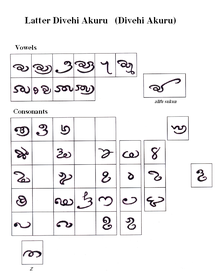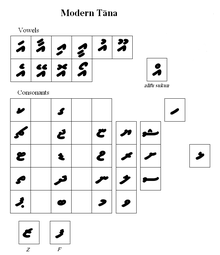Maldivian writing systems
The Divehi or Dhivehi writing systems are the different scripts used by Maldivians during their history.
The language of the Maldives has had its very own script since very ancient times. It is likely that the first Maldivian script appeared in association with the expansion of Buddhism throughout South Asia. This was over two millennia ago, in the Mauryan period, during emperor Ashoka's time. Manuscripts used by Maldivian Buddhist monks were probably written in a script that slowly evolved into a characteristic Maldivian form. Unfortunately none of those ancient documents have survived and presently the early forms of the Maldive script are only found etched on a few coral rocks and copper plates.
Ancient Scripts (Evēla Akuru)

Divehi Akuru or Dhivehi Akuru (island letters) is a script formerly used to write the Divehi (or Dhivehi) language. Unlike the modern Tāna (Thaana) script, Divehi Akuru has its origins in the Brahmi script and thus was written from left to right.
The Divehi Akuru or Maldivian script was separated into two variants, namely a relatively more recent and an ancient one and christened “Dives Akuru” and "Evēla Akuru" respectively by H.C.P. Bell in the early 20th century. Bell was a British gentleman who studied Maldive epigraphy when he retired from the colonial government service in Colombo.
Bell wrote a monograph on the Archaeology, history and epigraphy of the Maldive Islands. He was the first modern scholar to study these ancient writings and he undertook an extensive and serious research on the available epigraphy. The division that Bell made based on the differences he perceived between the two variants of Divehi Scripts is indeed convenient for the study of the old Maldivan documents.
The Divehi Akuru developed from the Grantha script. The early form of this script was also called Divehi Akuru by Maldivians, but it was called Evēla Akuru (ancient letters) in a tentative manner by H.C.P. Bell in order to distinguish it from the relatively more recent variants of the same script. This name became established and so the most ancient form of the Maldive script is now known as Evēla Akuru. This is the script that evolved at the time when the Maldives was an independent Buddhist Kingdom and it was still in use one century after the conversion to Islam.

The ancient form of the Divehi Akuru (Evēla) can be seen in the Lōmāfānu (copper plate grants) of the 12th and 13th centuries and in inscriptions on coral stone (hirigā) dating back from the Maldive Buddhist period. Two of the few copper plate documents that have been preserved are from Haddhunmathi Atoll.
The oldest inscription found in the Maldives to date is an inscription on a coral stone found at an archaeological site on Landhū Island in Southern Miladhunmadulhu Atoll, where there are important Buddhist archaeological remains including a large Stupa. The Landhū inscription is estimated to be from 8th century C.E. This inscription is written in a script resembling the southern Grantha Script of the Pallava and Chola periods in South India. However, this does not mean that the Maldives were dependent from those kingdoms in the Subcontinent, for the Maldive Islands have been an independent nation practically all along their history. There has been very little interference, cultural or otherwise, from other neighboring kingdoms in South India and Sri Lanka.
Even at that time the local script was known as "Divehi Akuru" (our letters) by Maldivians because another non-Maldivian script was used in the country. This was a Devnagari script related to Bengali and it had a kind of ceremonial value. The oldest paleographically datable inscription found in the Maldives is a Prakrit inscription of Vajrayana Buddhism dating back to the 9th or 10th century AD This inscription is written in an early form of the Nagari script. Thus the name "Divehi Akuru" was used historically by Maldivians to distinguish their own writing system from foreign scripts. Foreign scripts were learned and introduced at that time when Maldivian monks visited the Buddhist learning centres of Nalanda and Vikramashila.
Divehi or "Dives Akuru"

Divehi (or Dhivehi) Akuru, the later form of the Maldivian script was the script that evolved from the ancient Maldivian script or Evēla Akuru after the conversion of the Maldives to Islam. It was still used in some atolls in the South Maldives as the main script until around 70 years ago. Since then it is rarely used, not even having a ceremonial role in scrolls of coats-of-arms or badges of government entities and associations, where Arabic is favoured.
This script can still be found on gravestones, and some monuments, including the stone base of the pillars supporting the main structure of the ancient Friday Mosque in Male'. British researcher H.C.P. Bell obtained an astrology book written in Divehi Akuru in Addu Atoll, in the south of Maldives, during one of his trips. This book is now kept in the National Archives of Sri Lanka in Colombo.
Apparently, the Divehi or Dhivehi script was abandoned in other parts of the Maldives in favour of the modern Tāna script about 200 years earlier, perhaps at the beginning of the 18th century. Some modern Maldivian historians want to believe that the Tāna script was introduced a few centuries before that. But the claim that the Tāna letters were devised in the 16th century is not supported by historical documents, for the oldest writing specimens in the Tāna script, interspersed with Arabic, are from the 18th century and those are written in a crude early version of this script called Gabulhi Thaana (incipient Thaana), where the Arabic numerals have not yet been slanted 45 degrees and still look like numbers. Since no ancient writings in Tāna written before that date have been found, it is doubtful that this new script could be much older.
The Modern Script

The main reason why the Divehi Akuru were abandoned in favour of the Tāna script was owing to the need the learned Maldivians had to include words and sentences in Arabic while writing in the Divehi language.
The most intriguing fact about the Tāna alphabet is its order (hā, shaviyani, nūnu, rā, bā, etc.). Its order doesn’t follow the ancient order of the other Indic Scripts (like Sinhala or Tamil) or the order of the Arabic alphabet. In fact the order of the Tāna alphabet doesn’t follow any logic at all. This fact points to a likely esoteric origin of Tāna, namely to a script that was scrambled on purpose in order to keep it secret from average islanders. At their origin the Tāna characters, which are based on Arabic numerals and other symbols, were used in fandita (local magic or sorcery) to write magical spells. Many of these arcane incantations included Arabic quotations, which were written from right to left. Maldivian learned men, who were all well versed in sorcery, eventually saw the advantages of writing in this simplified hidden script. Hence, with the passing of time, Tāna came out of the shadows and was gradually adopted for everyday use.
This script is currently in use as the sole Maldivian writing system. While at their origin documents written in Tāna were full of Arabic words and quotations, the tendency is now to include as little Arabic script as possible, especially since special Thaana letters with dots were introduced to replace Arabic letters. The Thaana script is widely used nowadays by Maldivians both in official and unofficial documents, for the literacy rate of the Maldive society is very high by South Asian standards.
The ‘DIVEHI AKURU’ Book
In 1959, during Sultan Mohammed Farid’s reign, former Prime Minister (and later President) Ibrahim Nasir expressed a wish to have a book written about the former Maldivian script which by that time was largely ignored by Maldivians. Thus, he contacted As-Sayyid Bodufenvalhuge Sidi, an eminent Maldivian scholar, who swiftly obliged.

By means of this small book Bodufenvalhuge Sidi (1888-1970) wanted to clearly show the fact that in ancient times Maldivians were writing from left to right in their own script. Hence ‘DIVEHI AKURU’ is perhaps the only book ever written in Tāna that opens from the left side.
As-Sayyid Bodufenvalhuge Sidi was one of the very few Maldivian people of modern times who understood the now-forgotten ancient Divehi letters in which parts of royal grants, warrants and deeds were written. He learnt this ancient script in Addu Atoll. Until early in the twentieth century, all government correspondence to and from Addu Atoll was written using these ancient Divehi letters.
The last chapter of this book shows a text where the Divehi Akuru are coming along with Arabic script. As the reader acquainted with Maldivian writing can see, this book is Volume 1 (evvana bai). Perhaps Bodufenvalhuge Sidi had the intention of publishing a second, or perhaps even a third volume on the subject. But unfortunately this important Maldivian learned man died before being able to do so.
Even though H.C.P. Bell did a very careful and thorough research on the Maldivian documents, Prime Minister Ibrahim Nasir’s intention was to have a book on the ancient script of the Maldives written by a Maldivian. Prime Minister Nasir's request to Bodufenvalhuge Sidi was done in order to clarify H.C.P. Bell’s misinterpretations, no matter how few. A staunch Maldivian nationalist, Nasir took this issue as a matter of national pride.
Present day members of Maldivian cultural institutions are aware of the lacunae in Bell's research and of Bodufenvalhuge Sidi's valuable contribution to mend matters, but little has been done to correct those inaccuracies. Still, H.C.P. Bell’s broad and valuable contributions to the study of the Maldivian language and scripts should not be understimated.
References
- Bell , H.C.P. Excerpta Maldiviana. Reprint 1922-1935 edn. New Delhi 1998.
- Bell , H.C.P. The Maldive islands. Monograph on the History, Archaeology and Epigraphy. Reprint 1940 edn. Male' 1986.
- Bodufenvahuge Sidi. Divehi Akuru; Evvana Bai. Male' 1958.
- Divehi Bahuge Qawaaaid. Vols 1 to 5. Ministry of Education. Male' 1978.
- Divehīnge Tarika. Divehīnge Bas. Divehibahāi Tārikhah Khidumaykurā Qaumī Majlis. Male’ 2000.
- Geiger, Wilhelm. Maldivian Linguistic Studies. Reprint 1919 edn. Novelty Press. Male’ 1986.
- Gunasena, Bandusekara. The Evolution of the Sinhalese Script. Godage Poth Mendura. Colombo 1999.
- Romero-Frias, Xavier. The Maldive Islanders, A Study of the Popular Culture of an Ancient Ocean Kingdom. Barcelona 1999.
- Sivaramamurti, C. Indian Epigraphy and South Indian Scripts. Bulletin of the Madras Government Museum. Chennai 1999.
